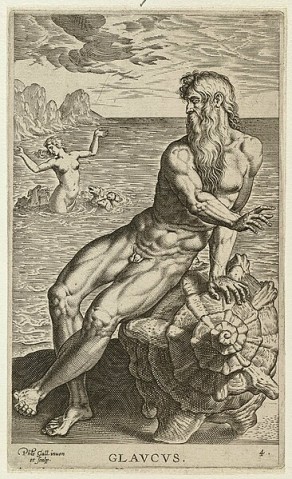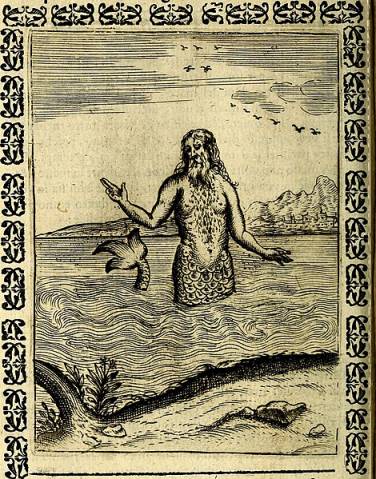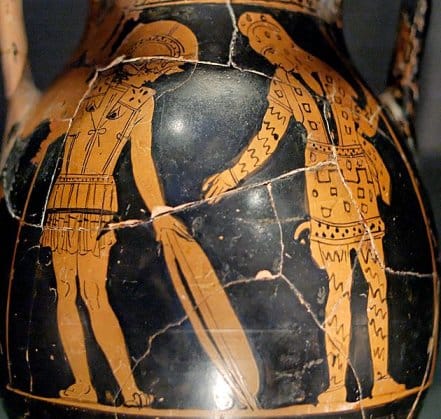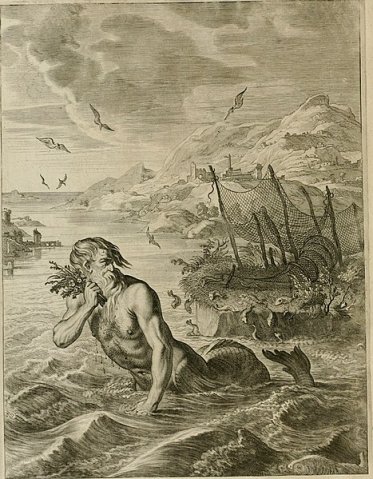In the vast tapestry of Greek mythology, certain figures stand out for their unique tales and characteristics. One such figure is Glaucus, a hero whose story intertwines with love, transformation, and the mysteries of the sea.
Glaucus Key Facts
| Parents | Polybus (in some versions) |
| Partners | Scylla |
| Siblings | Not prominently mentioned in myths |
| Offspring | None known |
| Other names | Glaukos |
| Roman name | Glaucus |
| Best Known Myth | His transformation into a sea god and love for Scylla |
Name and Etymology
The name “Glaucus” has its roots in the Greek word “glaukos,” which can mean “gleaming,” “silver,” or “bluish-green.” This is particularly fitting given his association with the sea, which often takes on these shimmering hues.
In Roman myths, he retains a similar name, “Glaucus,” showcasing the shared cultural elements between Greek and Roman tales. Apart from these, there are few epithets or alternative names associated with Glaucus, perhaps due to the specificity of his story and its focus on his transformation and tragic love.
Glaucus Family and Relationships

Glaucus was said to be the son of Polybus, though his lineage isn’t the most defining aspect of his tale. His story doesn’t dwell much on his early life or siblings. Instead, it plunges into the pivotal moment of his transformation. As a mortal, Glaucus was a fisherman. One day, upon discovering a magical herb that brought a fish back to life, he decided to consume it. This act transformed him, giving him sea-green hair, a fish’s tail, and the powers of prophecy. His new form led him to seek companionship, leading to his infatuation with the nymph Scylla.
Glaucus: The Sea Deity
The transformation of Glaucus from a mere fisherman to a revered sea deity is a testament to the unpredictable and wondrous nature of Greek mythology. But what does it truly mean to be a deity of the deep, and how did Glaucus fit into this divine role?

Worship and Reverence
As a sea deity, Glaucus was not as widely worshipped as the Olympian gods or even some of the more prominent sea gods like Poseidon. However, among fishermen, sailors, and coastal communities, he held a special place. These individuals, whose lives were deeply intertwined with the sea, would often invoke Glaucus’s name for protection, guidance, and bountiful catches. Small shrines dedicated to him could be found in select coastal regions, where offerings of fish, shells, and sometimes herbs reminiscent of his transformative tale would be made.
Powers and Abilities
Glaucus’s consumption of the magical herb not only changed his form but also bestowed upon him unique abilities. One of the most notable among these was the gift of prophecy. He could foresee events, guide lost sailors, and predict the outcomes of sea voyages. His deep connection with marine life also meant that he could communicate with and command sea creatures, making him a valuable ally for those navigating the treacherous waters.
Additionally, Glaucus had the ability to heal. There are tales of him restoring life to fish, which is what led to his fateful transformation in the first place. This power of rejuvenation was something that set him apart from other sea deities.
Role in the Pantheon of Sea Gods
The Greek pantheon is replete with gods and goddesses associated with the sea — Poseidon, Thetis, Nereus, and the Nereids, to name a few. Glaucus, with his unique origin story, occupied a niche space among these deities. He wasn’t born a god but became one through a twist of fate. This made him more relatable to mortals, especially those who spent their lives at sea. His tales were often shared as cautionary tales, but also as stories of hope, showcasing that the line between mortal and divine could sometimes blur in the most unexpected ways.
In essence, Glaucus’s role as a sea deity was multifaceted. He was a protector, a guide, a healer, and a beacon of hope for many who looked to the sea for their livelihood. His tales serve as a reminder of the mysteries that lie beneath the waves and the thin boundary that separates the world of mortals from the divine.
Myths about Glaucus

The Transformation of Glaucus
Glaucus’s transformation is a tale that begins with curiosity and ends in a metamorphosis that forever changes his destiny. As a mortal fisherman, Glaucus’s life was intrinsically tied to the sea. One fateful day, he stumbled upon a peculiar herb. Observing its magical properties — how it could bring a fish back to life — he was consumed by an insatiable curiosity. In a moment that would alter the course of his life, Glaucus decided to taste the herb himself. The effects were immediate and profound. His legs merged to form the tail of a fish, his hair took on the shimmering hue of the sea, and he found himself bestowed with the gift of prophecy. No longer a mere mortal, Glaucus had become a deity of the deep, a bridge between the world of men and the mysteries of the ocean.
The Unrequited Love for Scylla
With his new form and powers, Glaucus soon felt the sting of loneliness. His heart found solace in the beauty of the nymph Scylla. Enamored by her, he pursued her affections, hoping to share his newfound world with someone. However, Scylla, taken aback by his fish-like appearance, rejected his advances. Heartbroken but undeterred, Glaucus sought the assistance of the enchantress Circe, known for her vast knowledge of potions and spells. But love is a complex web, and Circe herself fell for Glaucus. When he did not reciprocate her feelings, a spurned Circe, in a fit of jealousy, poisoned the waters where Scylla bathed. The once-beautiful nymph was transformed into a monstrous creature with twelve legs and six heads, each with three rows of sharp teeth. This cruel twist of fate ensured that Glaucus and Scylla would never be together, adding another layer of tragedy to Glaucus’s tale.
Glaucus and the Argonauts
Glaucus’s divine status and wisdom made him a revered figure in many myths, one of which involves the legendary journey of the Argonauts. As Jason and his crew embarked on their quest for the Golden Fleece, they encountered numerous challenges and sought guidance from various deities. Glaucus, with his deep connection to the sea and prophetic abilities, played a pivotal role in their adventure. When the Argonauts found themselves in a perilous situation, Glaucus emerged from the depths, offering them sage advice and ensuring their safe passage. His involvement with the Argonauts not only highlights his divine stature but also showcases his benevolent nature, always ready to assist those in need.
Depiction And Characteristics
Glaucus is often depicted with sea-green hair, symbolizing his deep connection with the ocean. His lower body resembles that of a fish, a direct result of his transformation. Beyond his physical attributes, animals like fish and dolphins are frequently associated with him, representing his dominion over the sea’s creatures. His personality, as gleaned from myths, is one of passion and determination, especially in his pursuit of Scylla. As for artifacts, while there aren’t many directly linked to Glaucus, his story has been referenced in various ancient texts and artworks, emphasizing his role in Greek mythology.
Representations Of Glaucus In Art

Glaucus, with his unique transformation and tragic love story, has been a captivating subject in the realm of ancient art. His depictions offer a window into how ancient civilizations perceived and interpreted his myths.
“Glaucus and Scylla” by Bartholomeus Spranger
One of the most iconic artworks that capture the essence of Glaucus’s tale is “Glaucus and Scylla” by Bartholomeus Spranger. This piece beautifully encapsulates the tragic love story between the transformed sea god and the nymph. Spranger, a renowned artist of his time, managed to convey the raw emotions and the intricate dynamics of their relationship in this artwork. The piece not only showcases Glaucus’s distinctive sea-god appearance but also highlights Scylla’s beauty before her monstrous transformation.
“Circe Invidiosa” by John Waterhouse, 1892
While not directly about Glaucus, this artwork by John Waterhouse depicts the sorceress Circe, who played a pivotal role in Glaucus’s myth. Titled “Circe Invidiosa,” or “Jealous Circe,” it portrays the moment Circe poisons the waters where Scylla bathed, out of jealousy towards Glaucus’s affection for the nymph. Waterhouse’s rendition is deeply evocative, capturing Circe’s intense emotions and the impending doom for Scylla. The painting is a testament to the intertwined fates of Glaucus, Scylla, and Circe.
These artworks, among others, provide invaluable insights into how ancient and later civilizations visualized and interpreted the myths surrounding Glaucus.
Mentions in Ancient Texts
Glaucus’s narrative has been touched upon by several ancient writers, each offering a unique perspective and shedding light on different facets of his tale.
Homer’s “Iliad”
In the “Iliad,” one of the most celebrated epics of ancient Greece, Homer introduces Glaucus not as the sea deity but as a valiant warrior and leader of the Lycians. This mention is brief, but it provides a glimpse into another dimension of Glaucus’s character. Moreover it is portraying him as a formidable figure on the battlefield.
Ovid’s “Metamorphoses”
Ovid’s “Metamorphoses” is a treasure trove of myths and legends. In it we find a detailed account of Glaucus’s transformation and his tragic love for Scylla. Ovid paints a vivid picture, describing Glaucus’s discovery of the magical herb and the profound changes it wrought upon him. The poet also delves deep into Glaucus’s feelings for Scylla and the unfortunate events that followed. A notable excerpt from this work reads: “Changed as I was, I plunged beneath the waves, and, with the other ocean-deities, dwelt in the depths.”
Apollonius Rhodius’s “Argonautica”
In “Argonautica,” a lesser-known but equally fascinating text, Apollonius Rhodius recounts the adventures of Jason and the Argonauts. Glaucus makes an appearance as a wise sea deity, offering guidance to the heroes during their perilous journey. His role underscores his deep connection with the sea and his newfound status as a divine being post-transformation.
Frequently Asked Questions
Glaucus consumed a magical herb that he saw revive a fish, leading to his transformation into a sea deity.
He fell deeply in love with the nymph Scylla.
He’s often shown with sea-green hair and the lower body of a fish.
No, Scylla was repulsed by his appearance and rejected his advances.
He sought the assistance of the sorceress Circe.
Yes, he’s mentioned in works like Homer’s “Iliad” and Ovid’s “Metamorphoses.”
Featured Image Credit: Peter Paul Rubens, Public domain, via Wikimedia Commons
